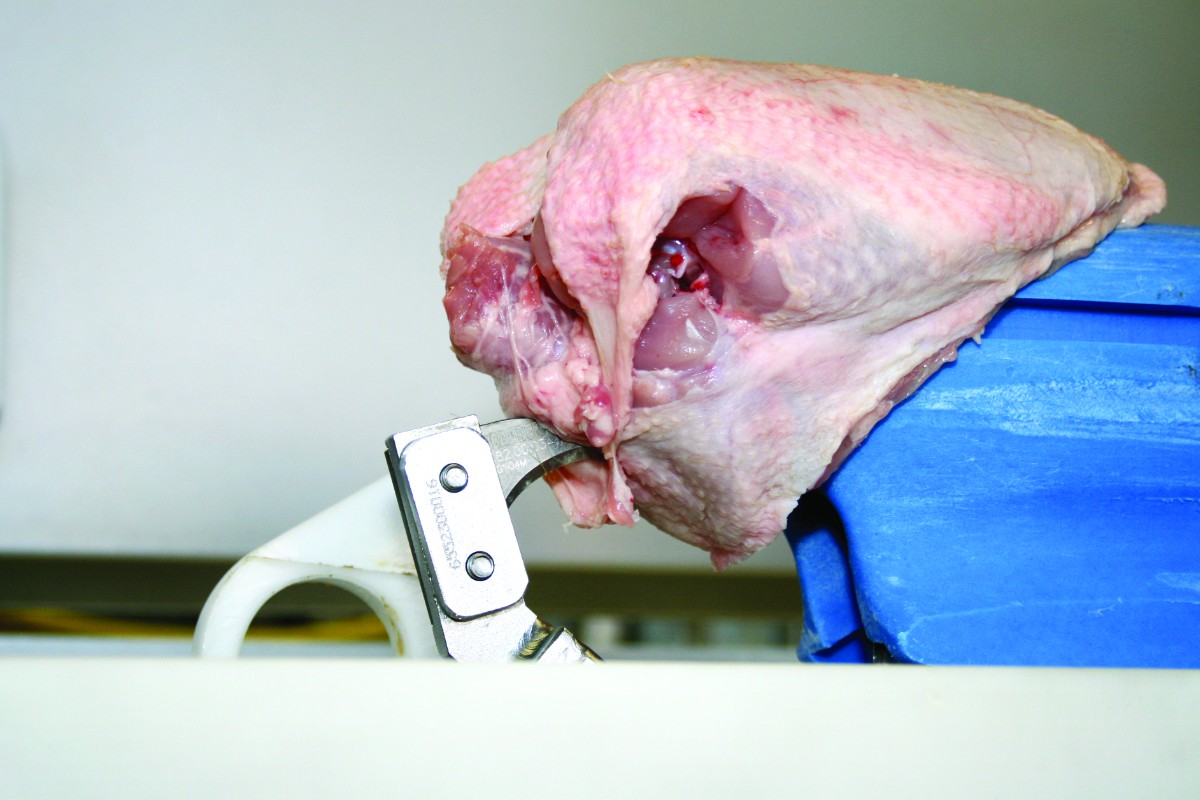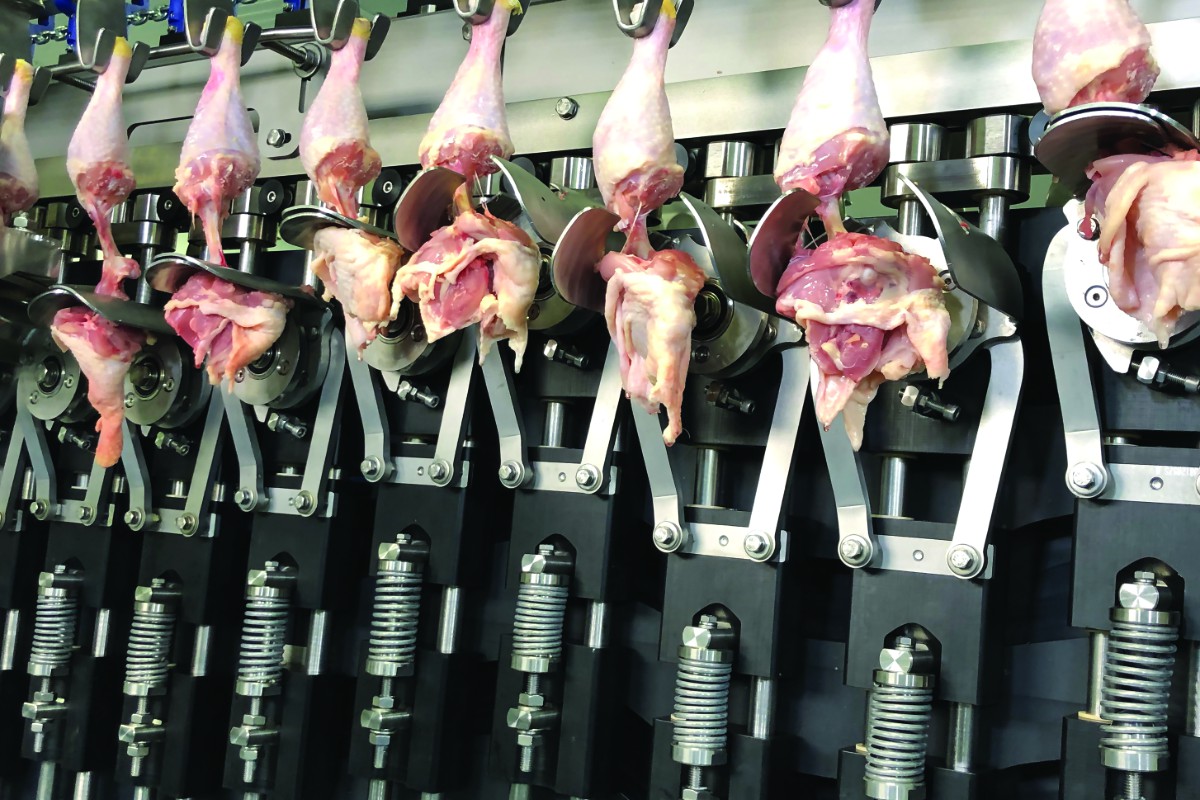It’s a tough job, but someone’s got to do it. Or do they? Or do they have to do it the same way?
Workers who perform manual deboning work on poultry lines face challenges ranging from immediate injuries like cuts to long-term-use injuries from repetitive motion. It’s a difficult job to fill, given the skilled type of work involved and one that is done in a harsh environment for up to eight hours a day. It’s also a job that has a significant impact on processors’ yields, quality and profits.
The booming economy and other domestic factors have compounded the labor issue. “The demand we’re seeing (in deboning solutions) has been forced by the labor situation,” reports Simon Langhorn, key account manager for Marel, with US offices in Lenexa, Kansas. “The considerations are in reducing labor. They want something that shows up every day and takes minimal operation to run.”
While the economy is good now, the labor tightness may not get easier for this role even if the pendulum swings back again, given the fact that it is often a difficult job. “These plants are also in rural areas (that can be hard to recruit from) and at the same time, it isn’t easy,” points out Jay Russell, vice president of sales for Meyn, with US offices in Atlanta, Georgia.
At the same time, poultry processors contend with other challenges that impact the deboning process, from the need to reduce bone contaminants in products to keeping up with desired line speed and volumes. Optimizing yield is also crucial during the deboning process. Meanwhile, market fluctuations, swinging between high poultry supplies and a deficiency of boneless chicken cuts from smaller birds, mean a greater priority on getting as much margin and profit out of products as possible.
Flocking to foodservice
Finding resource-saving ways to debone poultry without sacrificing yield and efficiency isn’t a short-term quest or fix. In addition to fresh boneless cuts like breast filets, tenders and thighs, boneless portions are used to make popular items like chicken nuggets and chicken or turkey pieces in prepared meals. Boneless products are especially hot in the quick-service restaurant industry, where chains specializing in boneless chicken, like Chick-fil-A and Raising Cane’s, have experienced sales increases of more than 15 percent. Boneless chicken is also in demand at globally inspired restaurants, like those offering chicken shawarma or Asian-flavored bowls on menus.
Poultry plants are investing in deboning systems at different levels to improve performance and efficiency. Claxton Poultry Farms, for example, announced a new $12 million chicken deboning and packaging facility in Sylvania, Georgia, as it supplies companies around the country, including Chick-fil-A and Popeye’s. Sanderson Farms has gone in big with boneless poultry processing, building a $155 million greenfield plant for deboning big birds in St. Pauls, North Carolina.
As demand for boneless poultry products stays strong, supplies vacillate and the labor crunch continues, processors utilize deboning tools and equipment to help challenges associated with that task. Increasingly, those systems are automated or at least more automated than the traditional, manual methods of deboning.

Measuring up
Addressing carcass variability and processors’ needs for flexibility, the latest automated deboning systems are designed to measure each bird, using imaging systems and sophisticated software to account for inconsistencies and adjust for those measurements to achieve optimum yield. While there can be some trade-off between automation and yield, the labor issue has been so acute that investments in automation, or automation with some manual workers, can reap immediate benefits. As Langhorn puts it, “There are trade-offs. You can get less yield than on a cone line but save more year after year with labor savings.”
Meyn’s Russell agrees. “There is no machine that will perform as well as a person at the best of their ability, but also, there is no perfect ability all of the time – people get tired or they may just be ‘off’ that day. With automation, especially with breast deboning, we are offering a long-term profitability scenario. The return investment is a no brainer in terms of how fast it can be paid off in labor savings,” he says.
According to Langhorn, Marel has focused on labor-saving versatility, with its AMF-1 breast cap filleting system and FHF-XB front half deboning system. The FHF-XB can automatically debone front halves, and the AMF debones breast caps. Workers then manually harvest the removed breast or fillet meat. “It’s all more flexible, and you have to be in a tight weight range,” he explains, adding that the machines can cut labor by 50 percent.
Baader, with US offices in Kansas City, Kansas, offers breast deboning systems including the BA656 and ProFlex Cut Up line system, built around the concept of flexibility for users to process a range of bird sizes. The BA656 allows an operator to measure each front half to adapt the deboning process to the bird and is also adjustable during production. The ProFlex line features a BA632 machine that cuts and removes meat from the bone. Both systems save on labor, says marketing coordinator Alex Pangilinan. “The BA656 requires two leaders, eight fillet trimmers and six tender clippers, saving 19 people on average,” he reports. Baader also offers the BA632 tight fillet system that uses seven workers to do 115 birds a minute, cutting the labor requirement of the closest competitor by at least half, Pangilinan adds.
Meyn offers dozens of different deboning solutions, according to Russell, and recently added semi-automated loading capability as another way to alleviate labor challenges. “Even loading the machine has a human element – if we can further automate it, we’ll do that,” Russell says. In addition, Meyn also has come out with a new deboning solution for high-quality tenders.
Another high-tech system comes from Ball Ground, Georgia-based Foodmate, which introduced an ULTIMATE Whole Leg Deboner last year that uses an x-ray measuring system to measure the position of the kneecap and the length of the drum and thigh bone, relaying it to an automatic adjusting system for a precise cut at high speeds.

Foodmate also offers a new OPTiX Deboner that uses X-ray technology for detecting kneecap and thigh length to ensure the highest possible yields. “In addition, the OPTiX offers integration with the OPTI Flow Cut-up System and accommodates a wide variation of bird sizes,” says Scott Hazenbroek, president of Foodmate US.
For high-volume processors with high-speed lines, as well as smaller processors looking to ramp up throughout, automated deboning systems can keep things moving during this part of the process. For instance, Baader’s BA656 handles birds at a rate of 85 to 100 front halves per minute. Foodmate’s whole leg deboner is capable of processing up to 6,000 legs per hour, while the OPTiX deboner can debone up to 14,400 thighs per hour.
Meyn recently introduced a high-speed deboner, the Rapid Plus M4.1, which boosts capacity up to 7,000 breasts per hour, requiring three workers to manually load the breasts on the carrier and seven workers to trim. That compares to manual deboning and trimming that results in 170 breasts per hour per worker. The automated system also features a modular design and is said by the company to save up to 33 full-time employees per shift.
Hand tools are also being improved to alleviate labor issues associated with trimming and deboning. Bettcher Industries, Birmingham, Ohio, recently rolled out a new line of lighter-weight handheld trimmers. The Quantum Flex trimmers feature faster blade speeds and quicker blade changeover with tool reconfiguration, according to Patrick Grabovac, product marketing manager.
“With manpower shortages being such a significant issue in the meat industry today, processors need more help than ever to capture every extra ounce of yield while relying on fewer workers to make it happen,” Grabovac explains.
The robotics club
As anyone who has recently attended an industry trade show knows, robotics are making their way to poultry plants, and that includes robotic deboning. Compared to fixed automation, robotics allow for even greater flexibility in deboning birds. Work on this technology is being done, among other places, at the Agricultural Technology Research Program at Georgia Tech Research Institute (GTRI) in Atlanta. Researchers there have been working with robots that can put front halves of chicken on cones for deboning.
Still, workers will likely always be a part of deboning lines in some way or other, because of the sight and oversight needed to ensure quality. Employees will be needed to operate and maintain deboning systems, do quality control checks on the line and in some cases, do manual harvesting.


